Unpretentious flowers for giving

A modern dacha is gradually turning from a place of intense gardening and gardening into a recreation area. But many lush flowers that are pleasing to the eye keep you busy. It is not difficult to solve this problem - you just need to know the main types of non-capricious cultures and the rules for handling them.
Overview of perennial species
Finding out the names of the most unpretentious flowers for a summer residence is appropriate already because this will destroy the stereotype about the "extreme complexity" of the maintenance of flower beds. This opinion often scares away novice gardeners. AND it is worth starting a review of crops that refute this opinion with frost-resistant plants.
Even in most of the territory of Russia, they will delight summer residents from the first days of spring.
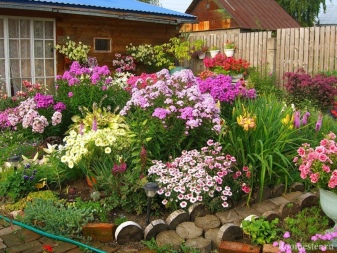
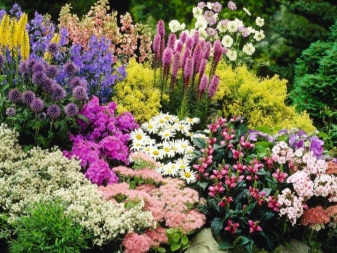
Literally from under the snow they rise, for example, crocuses. These are wintering bulbous flowers that form ovaries in the fall. They can be characterized by different colors:
- White;
- yellow;
- blue;
- striped.
Crocus bloom covers March, April and May. When the buds wither, the plants enter a dormant phase. The bulbs should be planted in August or September. Experts advise to choose for them thoroughly illuminated or partially shaded areas. For a shady garden, low crocuses are of little use, but under the curtain of bushes and trees that did not have time to bloom, the place is for them.
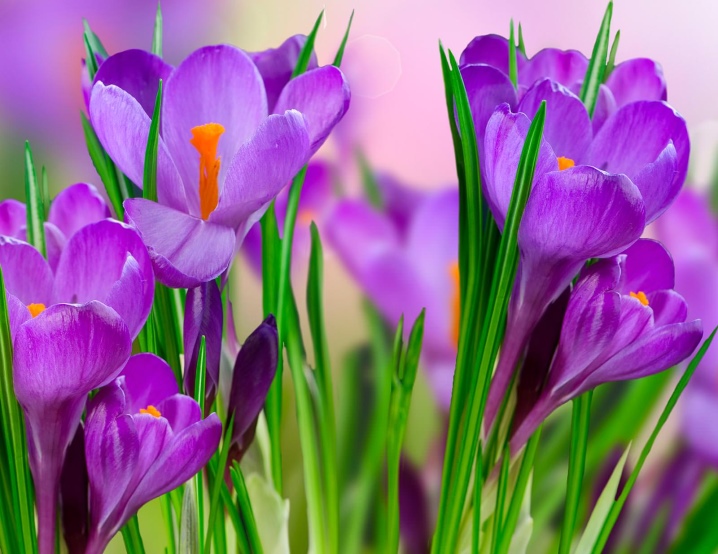
Bright flowers will be perfectly perceived in a group ensemble. You can also use them in an alpine slide, in a flower bed. Planting one or more crocuses in tapeworm format can make your spring lawn livelier.
As an alternative, you can consider muscari, aka mouse hyacinth... This plant lives in April and most of May. Muscari stems reach a height of 10-20 cm. Small bell-shaped flowers are formed on them. The number of plants will increase from year to year. Planting mouse hyacinth is recommended at the end of August or in the first 2-3 weeks of September. The plant is excellently combined with other primroses.
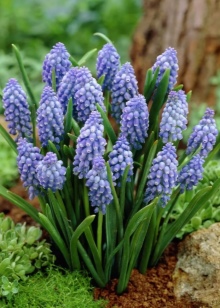
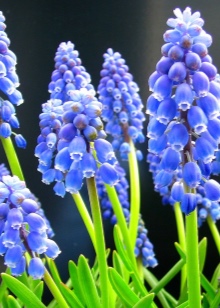
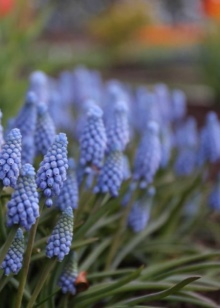
Deserves attention and Pushkinia... It forms curtains of green color. White, bluish and blue inflorescences rise above the leaves. Pushkinia will bloom from mid-April. A well-growing plant reaches 20 cm, flowers develop well in sun-drenched areas or in weak partial shade.
They can be used in conjunction with:
- primrose;
- small daffodils;
- dicenter;
- wintering varieties of stonecrops.
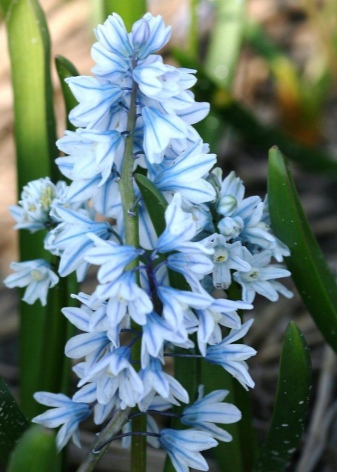
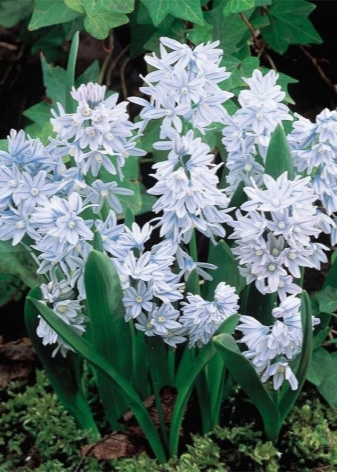
They deservedly received no less authority and tulips. These flowers are represented by hundreds or even thousands of varieties. They are successfully used both on ordinary flower beds and on alpine slides. Tulips begin to bloom in March, and in the latest varieties, flowering ends in the last spring days.
Important: different types of such crops react differently to frost, and these properties must be taken into account when choosing.

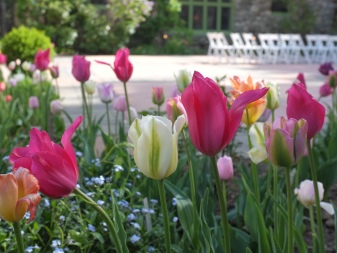
Development begins at the same time as the tulips daffodilscovering April and May. Daffodils are characterized not only by a pleasant appearance, but also by a very delicate aroma. The stem height varies from 30 to 60 cm. Double or simple flowers of various sizes develop on them.
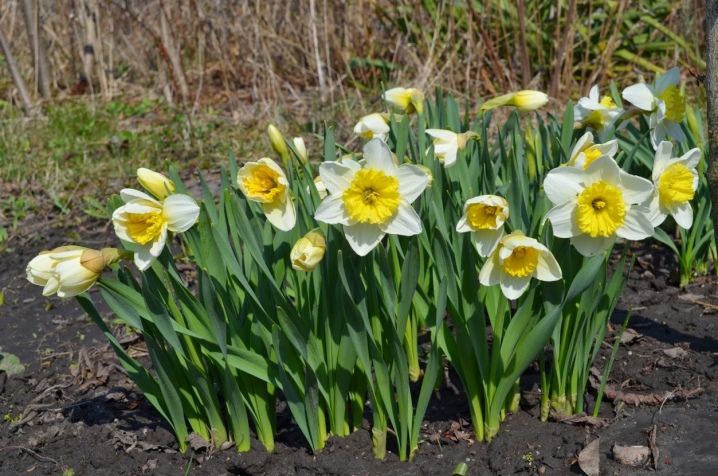
Curly country flowers deserve a separate discussion. This is about large-flowered campis... Their powerful vines are getting stronger every year. Bright green leaves of kampsis are decorative. Of all the specific types of care, only formative pruning and winter shelter are required (with the exception of the southern regions of Russia).
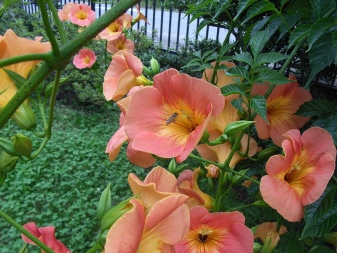
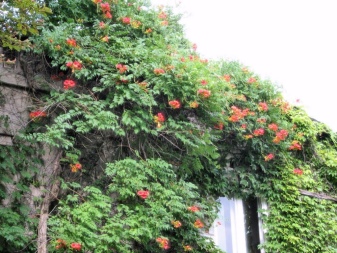
Quite sparing requirements for care are made Chinese lemongrass. The height of this plant can reach 4 m in our country. The flowers are small (1.5 cm), but they exude a sweet aroma. The flowers are initially white in color, but then gradually turn pink. You will need to make a support, control the growth of branches and mulch the trunk circle.
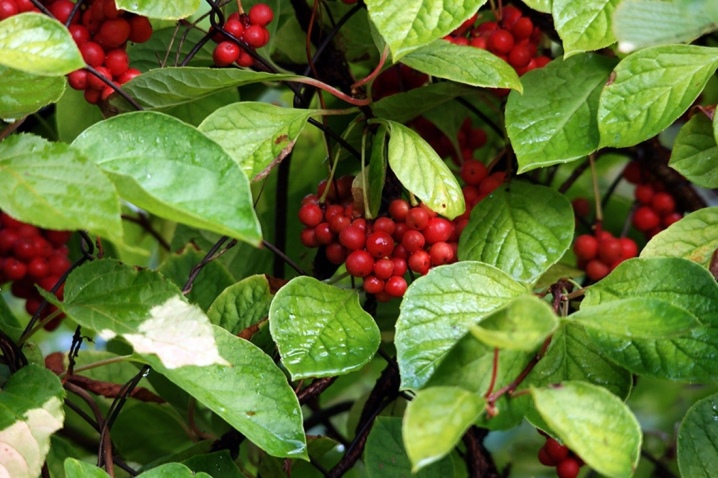
The third position in the list of unpretentious climbing perennials deservedly takes ivy... This is a shade-loving culture covered with many medium-sized leaves. Therefore, the ivy bush is completely green. The plant needs pruning, without which it will not be able to grow normally.
You can fear freezing in the central regions, but ivy will quickly recover under normal conditions.
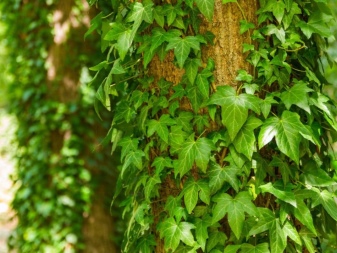
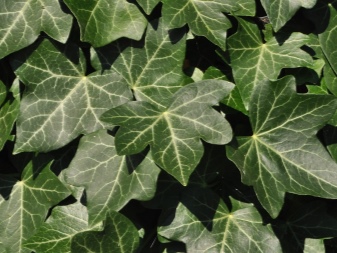
An alternative can be considered:
- curly honeysuckle;
- hop;
- large-leaved kirkazon.
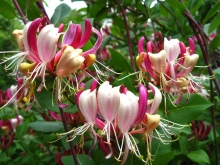
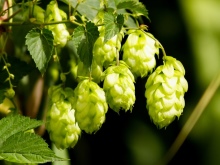
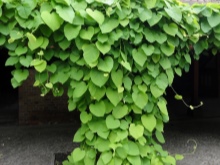
If you are not limited to climbing flowering crops, you should pay attention to periwinkle. It is good because it can be grown both in a sunny and shady place. The plant will bloom in the midst of spring. It covers new areas by rooting when it touches the surface of the earth. Periwinkle forms chic clumps of greens, diluted:
- white;
- blue;
- purple;
- pink spots.


DicenterLike a number of other beautiful cultures, it is shrouded in a halo of romantic legends. Developed rhizomes allow you to survive the winter almost without losses. The height, depending on the variety, is 0.3-1 m. The center looks spectacular, in the last month of spring it will be covered with racemose inflorescences of small hearts. Duration of flowering is approximately 30 days, however, in the weak shade of deciduous trees, the bleeding center looks brighter and retains its appearance longer.
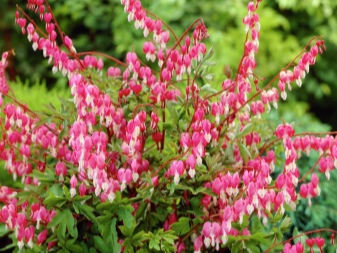
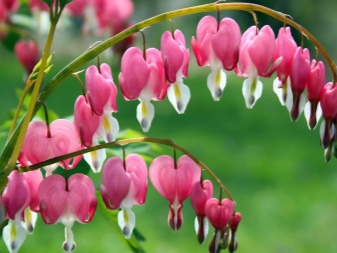
Good companions for this culture are:
- muscari;
- narcissus;
- fern;
- primrose;
- graceful types of onions.
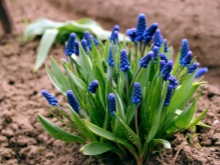

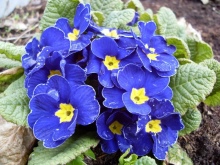
Sung in songs and poetry lily of the valley blooms in May. Its wintering is simplified by creeping rhizomes. There are 6-20 bell-shaped flowers per inflorescence. After flowering, the buds are replaced by reddish, slightly rounded berries. Lily of the valley can live in one place for up to 10 years.
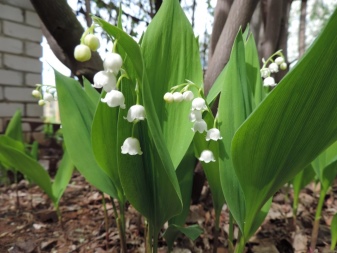

Lovers of forest plants need to focus on buy. This perennial will bloom during May and June. It is generally believed that kupena is not bright enough compared to other spring flowers.
However, you can reveal all its advantages by planting a flower near conifers and shrubs. There, a bush with a height of 30-80 cm will delight you with white or greenish bells.
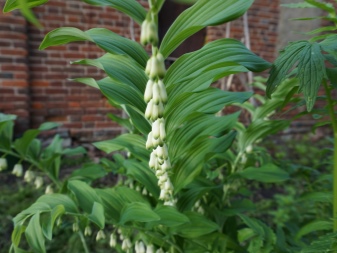
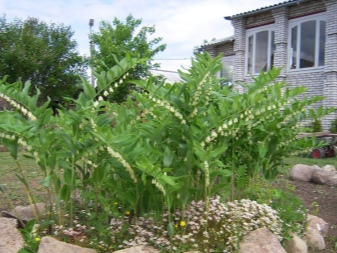
What annual plants to plant?
Strictly speaking, it is not so easy to separate an annual from a two-year-old. Many formally biennial plants under Russian conditions can develop normally for only one year. "Unpretentious" in this case means - growing without the use of seedlings. It is the preparation of it that gives a lot of trouble to flower growers.
With skillful selection, annual crops (or rather, ensembles of them) bloom all summer.
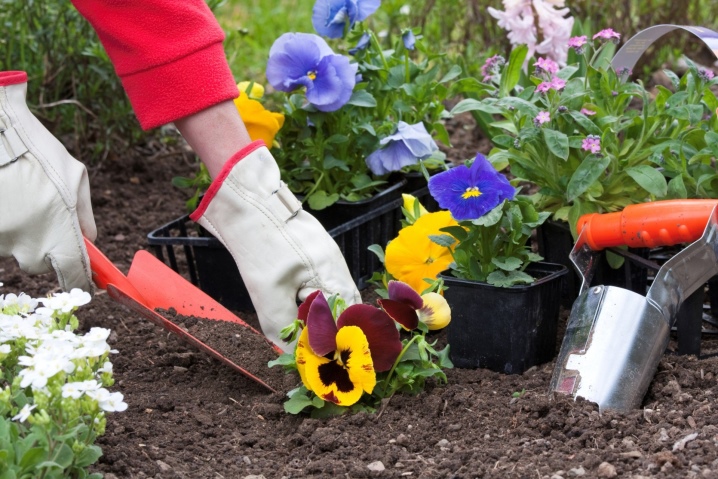
Cornflowers
For the lazy, cornflowers are very good. And not only for the lazy, but also for those who just want to look at something beautiful, but at the same time are very busy in everyday life. An interesting fact: in ancient times, the flower was named after the legendary centaur Ness. Modern biologists have established a much more objective fact - the cornflower comes from the south of Europe. This representative of the Asteraceae family develops optimally at temperatures not lower than +15 and not higher than +35 degrees Celsius.
In winter, you do not need to water cornflowers. However, they require bright sunlight. The cultivation of these maintenance-free flowers does not represent any other nuances. It is quite capable even for inexperienced gardeners and florists.
It should be borne in mind that in different cases the stalk of the cornflower grows straight or half-lying on the ground, and its height can be 1.2 m. The root system also differs in specific species.
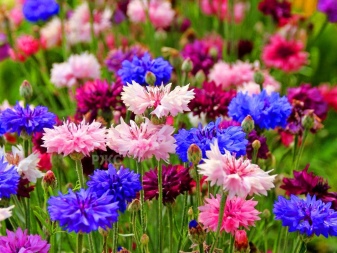
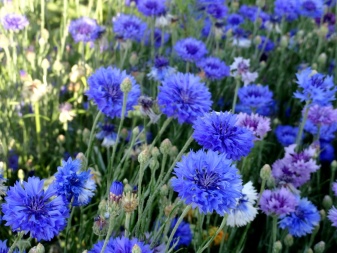
Most often, you can see a cornflower on the site:
- blue;
- White;
- mountain;
- large-headed;
- meadow;
- field.
Important: the distance when planting cornflowers should be at least 50 cm.Only under this condition, lush graceful bushes are formed. Cornflower is propagated by seeds and root cuttings. Sowing seeds is recommended to be done in April with subsequent thinning of the seedlings. It is also worth considering that many types of cornflowers can easily reproduce by self-seeding.

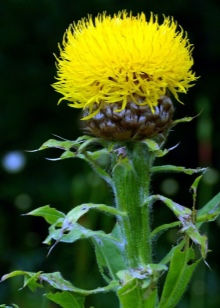

Delphinium
Not everyone wants to plant long-blooming flowers in flower beds - sometimes they want variety. Delphinium turns out to be an amazing choice in this case. This plant from the buttercup family has another name - larkspur.
Important: annual delphiniums are sometimes isolated into a separate genus of field pickers. The origin of the name of the culture has not yet been established for certain.
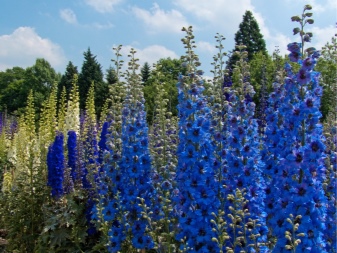
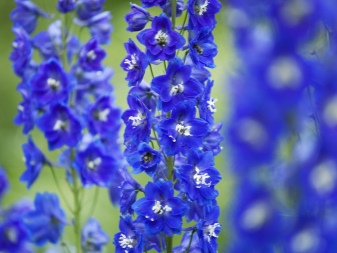
It is believed that it is associated either with the shape of an unopened flower (like a dolphin's head), or with its active cultivation in an ancient city called Delphi. In any case, today this plant is cultivated even more often than in Ancient Greece. Delphiniums in the morning should be illuminated by the sun. They must be protected from wind gusts. Location in places with excessively damp ground can also become disastrous.
You can cultivate a delphinium in one place for a maximum of 5 years. For Pacific species, this period is not more than 4 years. Further, the bushes will have to be divided and planted as independent plants. Hollow stems will need to be tied up several times during the entire time. With proper care, abundant flowering occurs in June.
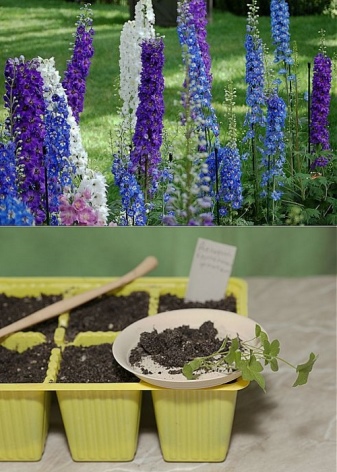
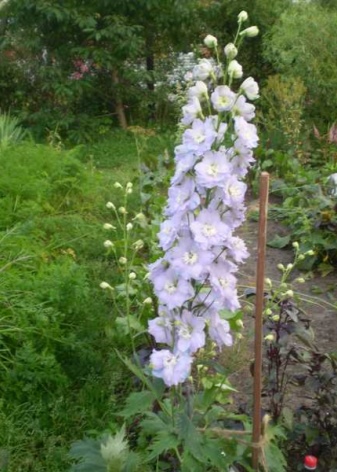
Calendula
This ornamental plant is unique in that it simultaneously has a number of medicinal properties. Preparations prepared on its basis have been helping people for several centuries. Gardeners value marigolds more for their pleasant appearance and long flowering. Most often, calendula is planted in groups to showcase the beauty of the yellow-orange combination. She is, among other things, a close relative of the aster.
Calendula is characterized by thick stems growing straight up. Its leaves are oval. The flowers will bloom at sunrise and close at sunset. They are delicious even on the rainy day. There are at least 20 species in the genus of calendula.
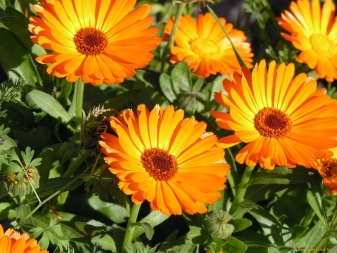
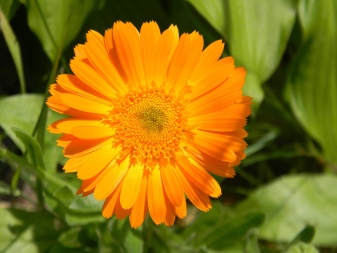
Kosmeya
When choosing a cosmos, you need to pay attention to the fact that this genus has both annual and perennial varieties. Like calendula, they all belong to the Aster family. The plant comes from Mexico. In a temperate climate, only 3 out of 20 species are cultivated so far. The height of the bushes ranges from 50 cm to 1.5 m.
The plants are quite graceful, with pink, purple, red, white flowers and a yellow center. Relatively recently, the terry variety of kosmea began to be used. Seeds retain their planting qualities up to 2-3 years after collection. The choice of growing seedlings or sowing in open ground is at the discretion of the growers.
But the second method, judging by the reviews, gives more reliable results.
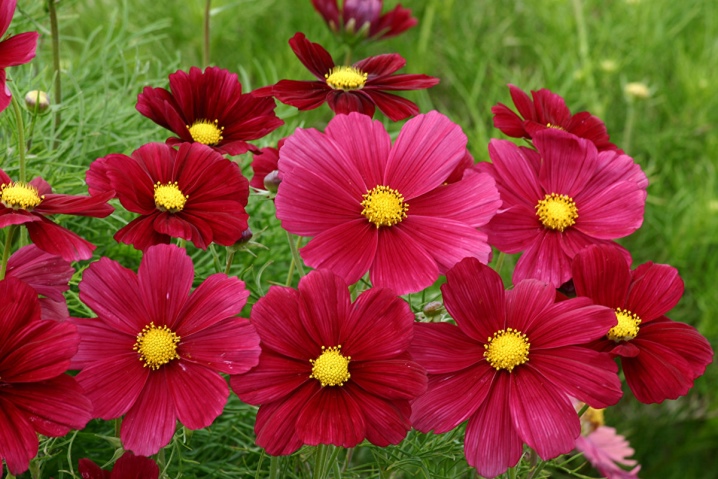
Lavatera
The wild rose is modest and charming. Biologists have established that it belongs to the Malvaceae family; for flower growers, however, more interesting is the fact that the lavatera is distinguished by its richness of colors. Depending on the height of the stems, the crop can be grown both in the garden and in a pot. With its help, you can make spectacular looking street compositions. Lavater is found naturally in Africa and southern Europe; it easily forms dense thickets.
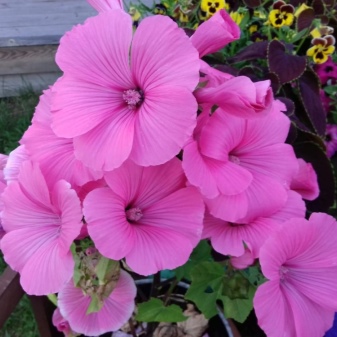
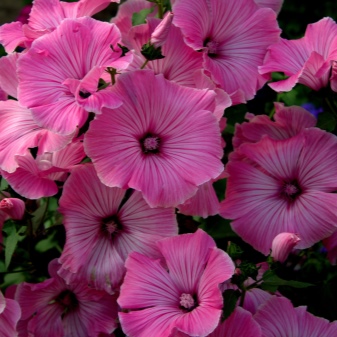
The characteristic features of the culture are:
- powerful branched rhizome;
- spreading of straight shoots;
- flowering from June to October inclusive;
- funnel-shaped corollas up to 10 cm long.
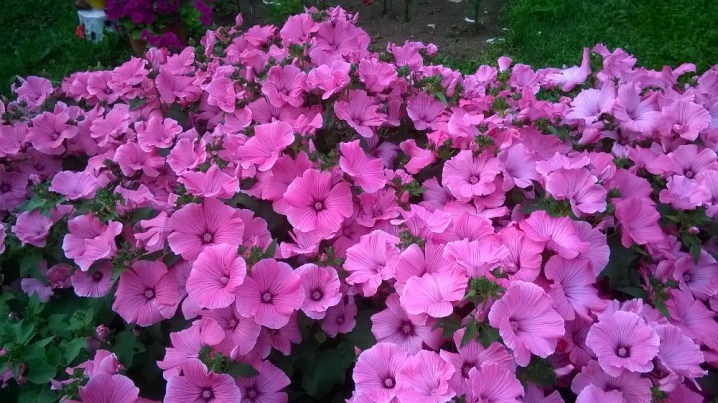
Nasturtium
This plant comes from the central and southern regions of America. There it was traditionally used for food. Now, according to various sources, 50-90 species of nasturtiums are cultivated. In the middle lane, none of them spend the winter. Semi-shrub nasturtium has a height of no more than 40 cm, and curly - up to 2 m.
Typical:
- strong branching of the stem;
- large thickness of fleshy shoots;
- the rounded shape of the thyroid leaves.
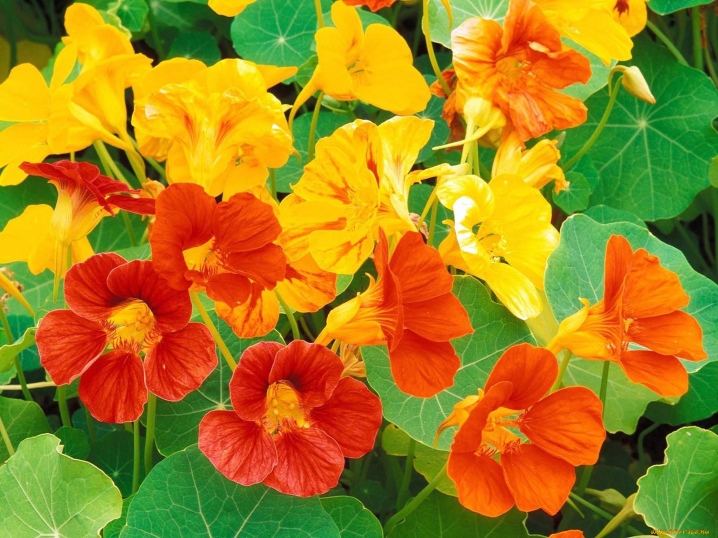
Rudbeckia
This genus contains up to 40 different species and is part of the Aster family. The natural area of rudbeckia is the North American prairies. The height of branched and simple shoots can vary from 50 cm to 2 m.The length of the leaf is 5-20 cm.The diameter of the basket-like inflorescences can reach 15 cm.
Any rudbeckia (except terry) is propagated by seeds. Sowing is possible immediately into open ground. The optimal disembarkation time is the last May decade. It is recommended to plant rudbeckia in well-lit areas.
The soil must be well permeable to water.
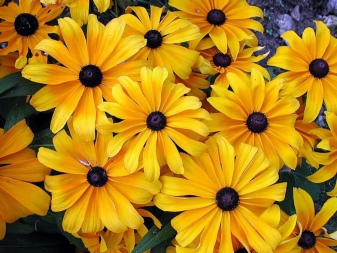
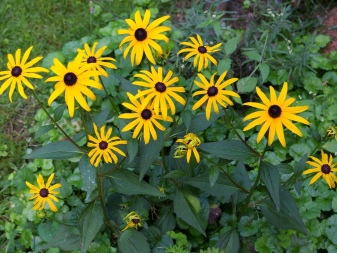
Marigold
These flowers, already familiar in our country, come from America. Even inexperienced growers can cope with their cultivation. The basic rule is that early planting brings flowering closer. Loose soil is very important for marigolds. Fertilizers are applied before planting, while manure cannot be used.

Phlox
The genus from the cyanose family includes up to 70 species, of which 40 have been introduced into culture. Like many other heroes of the review, phlox is found in North America. The positive features of the plant, along with unpretentiousness, are the fragrant aroma of flowers and long flowering. Each species can look very different depending on the climate in a particular location.
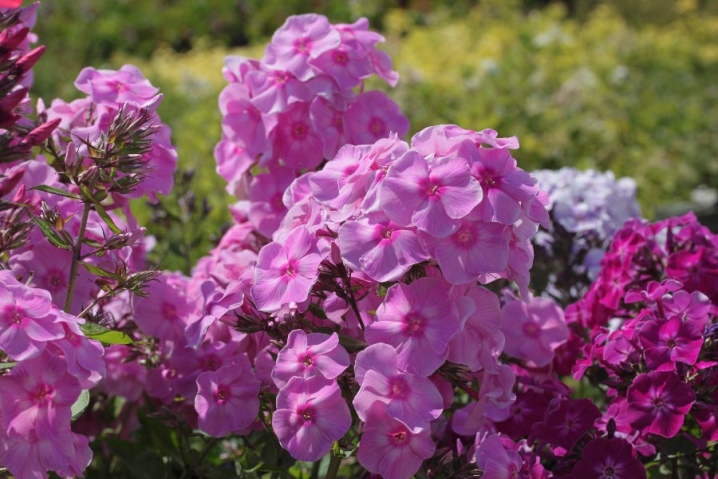
Other
Petunia is a relative of tobacco. It blooms throughout the season. Basically, hybrids are now used that have been bred since the first years of the twentieth century. Petunias are usually combined with begonia and pelargonium. But they can also be grown separately. And you can also recommend:
- salvia (aka sage);
- aster;
- erigeron (aka small-petaled).
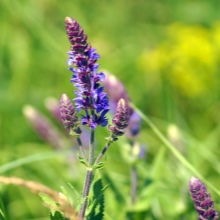
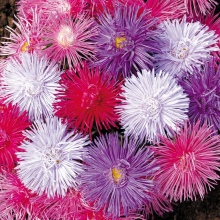
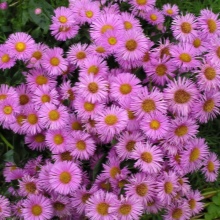
Care Tips
Timely watering of even unpretentious plants in the first 2 weeks is very important. If they are planted in peat tablets, you will have to water less and less often. Usually, if the weather is normal, there are no other indications for a particular plant, the flower beds are watered 2-3 times a week. Flowers should be watered sparingly. It is recommended to do this in the morning or evening. On a cold day, when it is humid at a depth of up to 5 cm, watering is not required.
Each time after watering, the soil must be loosened. Otherwise, a crust will form, which will harm the plants. In hot weather, mulching is very important to help retain moisture in the ground. Modern mulch can itself become a visual addition to a flower garden.
And whatever flowers are grown, weeds will have to be dealt with.
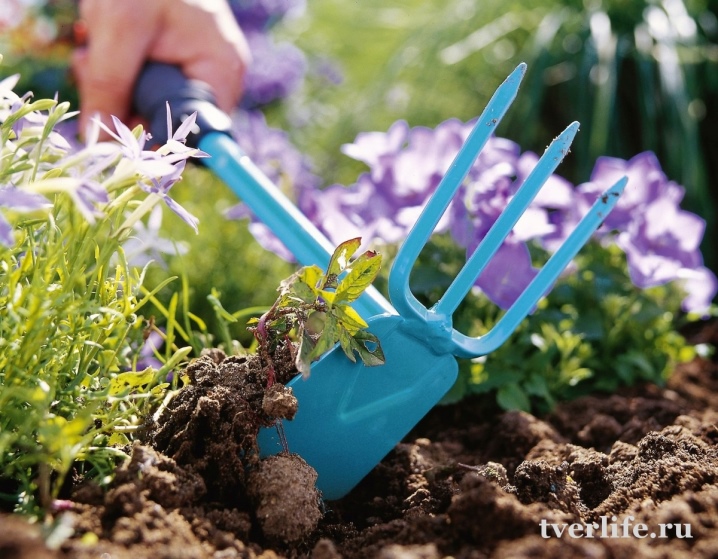
Examples in landscape design
It is useful to consider how beautiful flower arrangements from unpretentious plants can look like.
The photo shows a peony in one of the original garden compositions. Surrounded by greenery, its rich red flowers look very graceful.
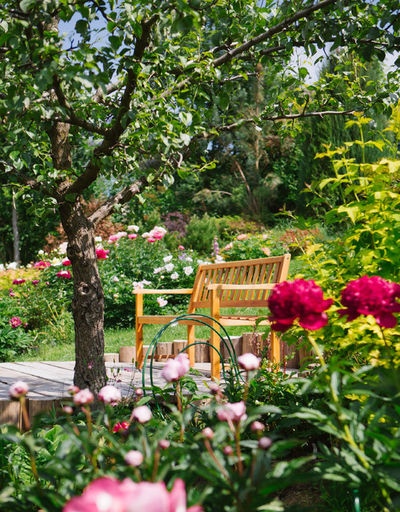
Together with grass, you can also grow day-lily - it is perceived no worse.
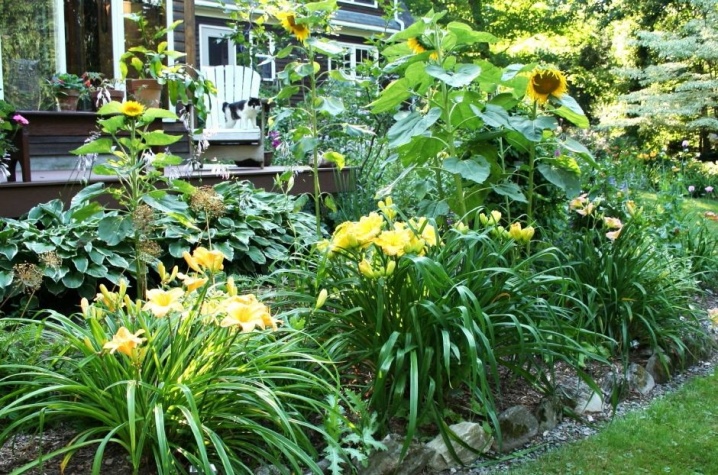
And here are some more unpretentious plants in the landscape:
- rudbeckia;
- delphinium;
- dicenter;
- hop;
- crocus.

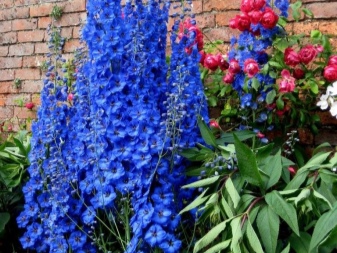
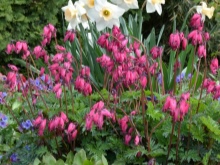
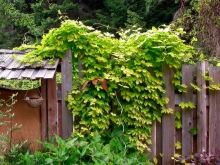
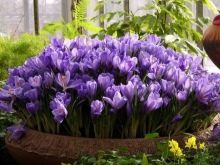
A selection of the most unpretentious colors is given below.







































































































The comment was sent successfully.